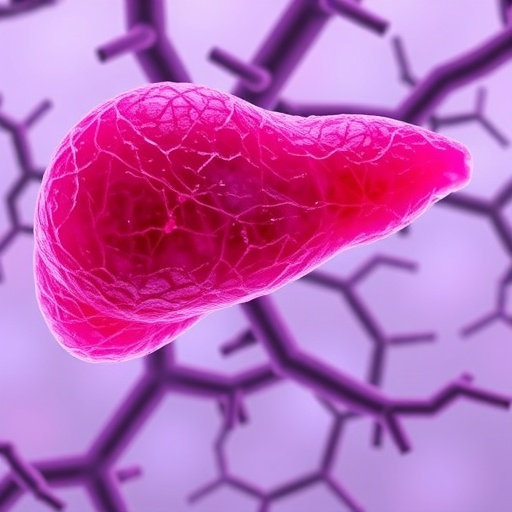In the relentless search for effective therapies against chronic liver disease, researchers at the Institute of Science Tokyo have engineered a groundbreaking human liver organoid that faithfully models the complex interplay fundamental to liver regeneration and fibrosis. This innovative 3D liver model, developed from human induced pluripotent stem cells (iPSCs), encapsulates hepatocytes and hepatic stellate cells (HSCs) in a spatial organization that uncovers crucial cellular crosstalk previously elusive in animal models. The advancement marks a significant stride toward understanding, preventing, and potentially reversing liver fibrosis, a pathological hallmark leading to cirrhosis and liver failure.
The liver’s ability to regenerate after injury is among the most remarkable feats of human biology. Yet, chronic injuries such as those caused by alcohol abuse, metabolic syndromes, and drug-induced toxicity trigger maladaptive repair mechanisms. Hepatic stellate cells, typically quiescent and vitamin A-rich in a healthy environment, become activated upon injury, transforming into myofibroblast-like cells that secrete extracellular matrix (ECM) components excessively. The resulting fibrotic scar tissue stiffens the liver, disrupting its intricate architecture and culminating in irreversible cirrhosis. Although liver transplantation remains the definitive treatment at late disease stages, it is plagued by donor shortages and complex complications, underscoring the urgent need for alternative therapeutic strategies.
Addressing this critical gap, the team at Science Tokyo devised an organoid system, termed iPSC-derived hepatocyte–stellate cell surrounding organoid (iHSO), which recapitulates native liver microenvironments more accurately than previous in vitro models. By differentiating human iPSCs into hepatocyte-like cells (iPS-Heps) and hepatic stellate-like cells (iPS-HSCs), then co-culturing them to form spheroids where stellate cells envelop hepatocytes, the system mimics the liver’s architectural and functional anatomy. This configuration allows direct observation of cellular signaling pathways governing repair and fibrogenesis, a feat impossible in monotypic cultures or animal surrogates.
A pivotal revelation from this model is the dualistic communication between stellate cells and hepatocytes mediated by the adhesion molecule ICAM-1 and cytokine interleukin-1β (IL-1β). The iHSO demonstrated that quiescent iPS-HSCs sustain a cytokine-rich environment that promotes hepatocyte proliferation via the ICAM-1–IL-1β axis, highlighting a supportive stellate cell phenotype in liver regeneration. This intricate signaling relationship elucidates how HSCs can act both as protectors during tissue repair and as drivers of fibrosis when dysregulated, providing critical insights into temporal therapeutic targeting.
Moreover, the iHSO exhibited robust responses to hepatotoxic insult, exemplified by exposure to acetaminophen, a common analgesic known to induce liver injury at high doses. The organoids mirrored pathophysiological injuries seen in vivo, including hepatocyte damage and subsequent stellate cell activation. This injury modeling capacity validates the iHSO as a valuable experimental platform for investigating drug-induced liver injury mechanisms and screening potential hepatoprotective agents, bridging a vital translational gap.
Chronic liver disease constitutes a burgeoning global health crisis, with over four million adults afflicted in the United States alone, and rising incidence rates documented in countries like Japan due to lifestyle and metabolic factors. Despite increased awareness, therapeutic options capable of halting or reversing fibrosis before catastrophic liver failure remain elusive. The human-based iHSO organoid presents a paradigm shift by offering a scalable, physiologically relevant tool for dissecting fibrosis evolution and for accelerating the discovery of anti-fibrotic drugs with greater predictive validity than existing animal models.
Beyond pathological applications, the organoid system opens new avenues in regenerative medicine. Understanding stellate cell heterogeneity — from quiescence to activation states — and their influence on hepatocyte survival and proliferation sets the stage for engineering next-generation bioartificial livers. Such constructs could one day supplement or replace conventional transplants, mitigating immunological rejection risks and donor scarcity.
The research team, led by Professors Sei Kakinuma and Yasuhiro Asahina alongside Assistant Professor Masato Miyoshi and graduate student Tomohiro Mochida, showcases how sophisticated in vitro models can powerfully simulate in vivo biology. Their findings, published in September 2025’s issue of Stem Cell Reports, underscore the transformative potential of organoid platforms in resolving complex cell-to-cell communication pathways essential to liver homeostasis and pathology.
This study not only validates the iHSO as a human-relevant model for liver fibrosis research but also spotlights ICAM-1 and IL-1β as promising molecular targets. Future therapeutic strategies might exploit these pathways to modulate stellate cell behavior, fine-tuning the balance between repair and fibrosis. Such interventions could forestall progression to cirrhosis, reducing the global burden of liver disease and diminishing the reliance on transplantation.
The Institute of Science Tokyo, born from the union of Tokyo Medical and Dental University and Tokyo Institute of Technology, reflects a forward-looking mission to harness fundamental and translational science in advancing human health. With the iHSO model, they have laid a solid foundation for future exploration of hepatic diseases, offering hope that one day, chronic liver injuries will be manageable and even reversible.
In sum, this pioneering organoid system provides a vital, human-based window into the cellular dynamics underlying chronic liver diseases. It redefines experimental possibilities in fibrosis research, opening pathways to innovative drug development and regenerative therapies. As the global community grapples with the rising incidence of liver pathologies, such scientific innovations stand to chart a new course toward addressing one of medicine’s most daunting challenges.
Subject of Research: Cells
Article Title: Crosstalk via ICAM-1 enhances supportive phenotype of stellate cells and drives hepatocyte proliferation in iPSC-derived hepatic organoids
News Publication Date: 18-Sep-2025
References:
Kakinuma S, Asahina Y, Miyoshi M, Mochida T, et al. Crosstalk via ICAM-1 enhances supportive phenotype of stellate cells and drives hepatocyte proliferation in iPSC-derived hepatic organoids. Stem Cell Reports. 2025 Sep 18. DOI: 10.1016/j.stemcr.2025.102642
Image Credits: Institute of Science Tokyo
Keywords: Liver damage, Diseases and disorders, Medical treatments, Clinical medicine, Health and medicine




